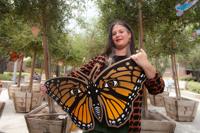
Kenneth Hahn State Recreation Area. (Photo by Amairani Hernandez.)
Last week, the Trust for Public Land released its annual ParkScore report, which evaluates park systems in the 100 largest U.S. cities, including seven in Southern California. This year, Los Angeles received the lowest ranking among them.
The annual ParkScore also selected Irvine, Long Beach, Santa Clarita, Santa Ana, Anaheim and Riverside for evaluation, as they are also considered the gold standard for parks. The system that was implemented when ranking the parks is solely based on the following factors: Park access, equity, acreage, investment measures and amenities.
Although Los Angeles fell four spots to number 90, park advocates believe that they should have a world-class park system but don’t. While some Southern California cities are investing in parks to build a greener future, others have yet to act on improvement recommendations even though parks are crucial to the social, physical and mental health of Latino communities.
Park access
According to Salud America, only one in three Latinos lives within walking distance of a park. Only19% of Latino children have access to recreational green spaces close to their neighborhoods, compared to 62% of white children.
Despite Los Angeles County being home to 4.75 million Latinos, the park system is failing them, as their top barriers to accessing green spaces are distance and transit connectivity. In the report, Los Angeles scored the third lowest, 61.8%, when it came to residents having parks within a 10-minute walk.
Nola Eaglin Talmage, who is the new director of the Parks for People program for Los Angeles, explained that another reason why Los Angeles scored the lowest among the other seven SoCal cities is because the city is not keeping pace with the population.
“So the score, although it was higher before, the population is changing, and therefore the access and the availability of parks are not necessarily keeping pace with what's happening in Los Angeles and we are not keeping pace with what other cities are doing to take care of park space in their cities,” Talmage said.
Even though the Parks for People program in Los Angeles has been around for some years now, one of the initiatives that they have been working on is trying to improve the 10-minute walk park access to residents in the community. By improving this criterion, they will be able to develop and focus on bringing more green space and amenities.
Lack of park access within walking distance for Latinos adds to existing health barriers and limits opportunities for physical activity and wellness. In the U.S. the prevalence and incidence of type 2 diabetes among the Latino population are higher than the dnational average.
The reason for this diabetes epidemic among the community is partly due to the sociocultural factors, such as lower income and decreased access to education and health care.
As the future of health coverage for many individuals is at risk, the chronic diseases that affect the Latino community specifically will only be on the rise. Green space needs to be accessible in Latino neighborhoods, as it is crucial for Latino kids to become more physically active.
Park investments
This year, Irvine ranked highest in the annual ParkScore, climbing two spots from last year’s 4th place, which became its best ranking ever. The rise in score is largely due to the ongoing progress on the city’s ambitious “Great Park” project.
According to the Trust for Public Land report, one of the reasons why Irvine parks scored the highest is because it prioritizes its green space and access to parks, which is something the Los Angeles parks are currently lacking.
The report notes that 94% of Irvine residents live within a 10-minute walk of a park, far ahead of the 76% national average. Irvine’s park investment of $681 per person is the highest among ParkScore cities in the U.S., far exceeding the national ParkScore average of $133. Among area cities, Santa Clarita, Santa Ana and Long Beach joined Irvine in investing more than the national average on parks as well.
Making green space a priority
Talmage believes that city priorities play a big role in improving the quality of parks for its residents. “Other cities have looked at their parks for rating or have prioritized the need for parks in their cities and have invested the money and the resources and capacity to either increase the acreage and access or invest in the existing parks and the amenities that are available there. Los Angeles has clearly not been sufficiently prioritized,” she said. “As someone who has been a project manager for green spaces and natural spaces in Los Angeles, it’s a lot of work, as there are a lot of overlapping agencies involved. It takes a number of years and you need to have the capacity within your organization for project managers to be able to see things through.”
She also stated that sometimes improving the parks in Los Angeles takes time due to the people involved and the process that they have to follow in order to receive either federal, local or state-level funding. “You need to have the capacity to write the grant and receive the grant, and then you need to have the capacity to continue on and to make sure that the park or the project you were going for the grant is able to be implemented,” Talmage said.
LA city park improvement recommendations
Although Los Angeles scored low in park acreage, which measures median park size and the share of city land devoted to parks, Talmage noted the city could boost its score next year by opening more public school parks and playgrounds for community use after school hours.
“We call that in the city of L.A. our community school parks, and right now, for the most part, all school playgrounds and parks are completely closed to the public … neighborhood after school hours, they're only available to the students,” she said.
Talmage also suggested that by forming partnerships with American Parks, the Los Angeles Unified School District, and other local districts to open school playgrounds would not only be ideal for the community but also the fastest way to move up in the list of the ParkScore report without investing major funding from the city.
Unfortunately, she said that in order to make that happen, it would involve a lot of negotiation, as they are a large entity. “As of now, Recreation and Parks has, sort of, historically, at least since 2008, been underfunded and has limited capacity to take on the maintenance and responsibility of those playgrounds if they were to be made open,” she said.
Another suggestion that Talmage made was looking more closely at some of the municipal right-of-way land that the city has, like those controlled by the Department of Water and Power. “Some of its easements or other utility easements could be easily developed to be a park and there's historical precedence of that,” she said. “We could look more closely at those spaces and work with those agencies to create plans to develop park spaces.”
Green spaces matter
Talmage firmly believes that when communities gather in parks or green spaces, it boosts health, reduces social isolation and strengthens community connection. Another reason she stresses the importance of green spaces is their role in reducing the urban heat island effect, especially in areas dominated by concrete and asphalt, as parks can be 10 to 30 degrees cooler.

Overview of the City of Los Angeles at Kenneth Hahn State Recreation Area. (Photo by Amairani Hernandez.)
Although Los Angeles’ park system declined in the rankings, the city still scores above the national average in recreational amenities for seniors.
“Parks bring people together and deliver enormous physical and mental health benefits for visitors,” said Dr. Carrie Besnette Hauser, president and CEO of Trust for Public Land.
“At a time when so much in our nation seems fractured or polarized, parks may be the last ideology-free zones, where everyone can come together, form meaningful relationships and enjoy a few hours of peace and relaxation. At Trust for Public Land, we will continue to work with park departments and leaders at all levels of government to realize the full community-building potential for parks,” Hauser added.












(0) comments
Welcome to the discussion.
Log In
Keep it Clean. Please avoid obscene, vulgar, lewd, racist or sexually-oriented language.
PLEASE TURN OFF YOUR CAPS LOCK.
Don't Threaten. Threats of harming another person will not be tolerated.
Be Truthful. Don't knowingly lie about anyone or anything.
Be Nice. No racism, sexism or any sort of -ism that is degrading to another person.
Be Proactive. Use the 'Report' link on each comment to let us know of abusive posts.
Share with Us. We'd love to hear eyewitness accounts, the history behind an article.